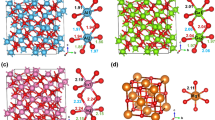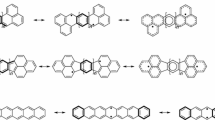Abstract
UMP2/aug-cc-pVTZ calculations are carried out to investigate the geometry, interaction energy and bonding properties of single-electron triel bond (SETB) interactions in binary X3Z···CH3 complexes, where Z = B, Al and X = H, F, Cl, Br, CN, NC, OH and CH3. The estimated binding distances are found to be in the range of 2.129–3.321 and 2.358–2.555 Å for X3B···CH3 and X3Al···CH3 complexes, respectively, which are much smaller than the sum of the van der Waals radii of corresponding interacting atoms. The strength of SETBs strongly depends upon the nature of the Z and X substituents. For a given Z atom, the presence of electron-withdrawing groups such as F or CN in ZX3 molecule tends to increase the absolute value of interaction energy, while a reverse trend is seen for the electron-donating groups (OH and CH3). According to quantum theory of atoms in molecule, all strong SETB interactions indicate a partially covalent character. The analysis of the intermolecular orbital interactions in the title complexes also indicates that the amount of charge transfer from the single-electron occupied p orbital of radical methyl to the empty p orbital of Z atom increases in the order CN > NC > H > CH3 > F > Cl > Br > OH.




Similar content being viewed by others
References
Scheiner S (1997) Hydrogen bonding. A theoretical perspective. Oxford University Press, New York
Gavezzotti A (2008) Non-conventional bonding between organic molecules. The ‘halogen bond’ in crystalline systems. Mol Phys 106:1473–1485
Metrangolo P, Resnati G, Pilati T, Biella S (2008) Halogen bonding in crystal engineering. Springer-Verlag, Berlin, Germany
Bauzá A, Quiñonero D, Deyà PM, Frontera A (2013) Halogen bonding versus chalcogen and pnicogen bonding: a combined Cambridge structural database and theoretical study. CrystEngComm 15:3137–3144
Esrafili MD (2013) A theoretical investigation of the characteristics of hydrogen/halogen bonding interactions in dibromo-nitroaniline. J Mol Model 19:1417–1427
Alkorta I, Elguero J, Del Bene JE (2013) Pnicogen bonded complexes of PO2X (X = F, Cl) with nitrogen bases. J Phys Chem A 117:10497–10503
Del Bene JE, Alkorta I, Elguero J (2014) Pnicogen-bonded anionic complexes. J Phys Chem A 118:3386–3392
Clark T, Hennemann M, Murray JS, Politzer P (2007) Halogen bonding: the σ-hole. J Mol Model 13:291–296
Murray JS, Lane P, Clark T, Politzer P (2007) σ-Hole bonding: molecules containing group VI atoms. J Mol Model 13:1033–1038
Politzer P, Murray JS, Lane P (2007) σ-Hole bonding and hydrogen bonding: competitive interactions. Int J Quantum Chem 107:3046–3052
Murray JS, Concha MC, Lane P, Hobza P, Politzer P (2008) Blue shifts vs red shifts in σ-hole bonding. J Mol Model 14:699–704
Murray JS, Lane P, Politzer P (2008) Simultaneous σ-hole and hydrogen bonding by sulfur-and selenium-containing heterocycles. Int J Quantum Chem 108:2770–2781
Politzer P, Murray JS, Concha MC (2008) σ-Hole bonding between like atoms; a fallacy of atomic charges. J Mol Model 14:659–665
Murray JS, Lane P, Politzer P (2009) Expansion of the σ-hole concept. J Mol Model 15:723–729
Murray JS, Lane P, Nieder A, Klapötke TM, Politzer P (2010) Enhanced detonation sensitivities of silicon analogs of PETN: reaction force analysis and the role of σ-hole interactions. Theor Chem Acc 127:345–354
Palusiak M (2010) On the nature of halogen bond—the Kohn–Sham molecular orbital approach. J Mol Struct Theochem 945:89–92
Metrangolo P, Murray JS, Pilati T, Politzer P, Resnati G, Terraneo G (2011) The fluorine atom as a halogen bond donor, viz. a positive site. CrystEngComm 13:6593–6596
Pavan MS, Prasad KD, Row TG (2013) Halogen bonding in fluorine: experimental charge density study on intermolecular FF and FS donor–acceptor contacts. Chem Commun 49:7558–7560
Kolář M, Hostaš J, Hobza P (2014) The strength and directionality of a halogen bond are co-determined by the magnitude and size of the σ-hole. Phys Chem Chem Phys 16:9987–9996
Wang W, Ji B, Zhang Y (2009) Chalcogen bond: a sister noncovalent bond to halogen bond. J Phys Chem A 113:8132–8135
Li Q-Z, Li R, Guo P, Li H, Li W-Z, Cheng J-B (2012) Competition of chalcogen bond, halogen bond, and hydrogen bond in SCS HOX and SeCSe HOX (X = Cl and Br) complexes. Comput Theor Chem 980:56–61
Adhikari U, Scheiner S (2014) Effects of Charge and Substituent on the S···N Chalcogen Bond. J Phys Chem A 118:3183–3192
Esrafili MD, Mohammadian-Sabet F (2015) Bifurcated chalcogen bonds: a theoretical study on the structure, strength and bonding properties. Chem Phys Lett 634:210–215
Alkorta I, Elguero J, Del Bene JE (2013) Pnicogen-bonded cyclic trimers (PH2X)3 with X = F, Cl, OH, NC, CN, CH3, H, and BH2. J Phys Chem A 117:4981–4987
Alkorta I, Elguero J, Solimannejad M (2014) Single electron pnicogen bonded complexes. J Phys Chem A 118:947–953
Alkorta I, Sanchez-Sanz G, Elguero J, Del Bene JE (2014) Pnicogen bonds between X horizontal line PH3 (X = O, S, NH, CH2) and phosphorus and nitrogen bases. J Phys Chem A 118:1527–1537
Alkorta I, Elguero J, Grabowski SJ (2015) Pnicogen and hydrogen bonds: complexes between PH3X(+) and PH2X systems. Phys Chem Chem Phys 17:3261–3272
Grabowski SJ (2014) Tetrel bond–σ-hole bond as a preliminary stage of the SN 2 reaction. Phys Chem Chem Phys 16:1824–1834
Esrafili MD, Mohammadirad N, Solimannejad M (2015) Tetrel bond cooperativity in open-chain (CH3CN)n and (CH3NC)n clusters (n = 2–7): an ab initio study. Chem Phys Lett 628:16–20
Murray JS, Lane P, Clark T, Riley KE, Politzer P (2012) σ-Holes, π-holes and electrostatically-driven interactions. J Mol Model 18:541–548
Smith EL, Sadowsky D, Cramer CJ, Phillips JA (2011) Structure, bonding, and energetic properties of nitrile-borane complexes: RCN-BH3. J Phys Chem A 115:1955–1963
Esrafili MD (2012) Characteristics and nature of the intermolecular interactions in boron-bonded complexes with carbene as electron donor: an ab initio, SAPT and QTAIM study. J Mol Model 18:2003–2011
Buchberger AR, Danforth SJ, Bloomgren KM, Rohde JA, Smith EL, Gardener CC, Phillips JA (2013) Condensed-phase effects on the structural properties of FCH2CN-BF3 and ClCH2CN-BF3: a matrix-isolation and computational study. J Phys Chem B 117:11687–11696
Wrass JP, Sadowsky D, Bloomgren KM, Cramer CJ, Phillips JA (2014) Quantum chemical and matrix-IR characterization of CH3CN–BCl3: a complex with two distinct minima along the B-N bond potential. Phys Chem Chem Phys 16:16480
Grabowski SJ (2014) Boron and other Triel Lewis Acid Centers: from Hypovalency to Hypervalency. ChemPhysChem 15:2985–2993
Grabowski SJ (2015) π-Hole bonds: boron and Aluminum Lewis Acid Centers. ChemPhysChem 16:1470–1479
Phillips JA, Giesen DJ, Wells NP, Halfen JA, Knutson CC, Wrass JP (2005) Condensed-phase effects on the structural properties of C6H5CN-BF3 and (CH3)3CCN-BF3: IR spectra, crystallography, and computations. J Phys Chem A 109:8199–8208
Buchberger AR, Danforth SJ, Bloomgren KM, Rohde JA, Smith EL, Gardener CCA, Phillips JA (2013) Condensed-phase effects on the structural properties of FCH2CN-BF3 and ClCH2CN-BF3: a matrix-isolation and computational study. J Phys Chem B 117:11687–11696
Smith EL, Sadowsky D, Phillips JA, Cramer CJ, Giesen DJ (2010) A short yet very weak dative bond: structure, bonding, and energetic properties of N2–BH3. J Phys Chem A 114:2628–2636
Eigner AA, Rohde JA, Knutson CC, Phillips JA (2007) IR spectrum of CH3CN-BF3 in solid neon: matrix effects on the structure of a Lewis acid–base complex. J Phys Chem B 111:1402–1407
Wrass JP, Sadowsky D, Bloomgren KM, Cramer CJ, Phillips JA (2014) Quantum chemical and matrix-IR characterization of CH3CN-BCl3: a complex with two distinct minima along the B–N bond potential. Phys Chem Chem Phys 16:16480–16491
Leopold KR, Canagaratna M, Phillips JA (1997) Partially bonded molecules from the solid state to the stratosphere. Acc Chem Res 30:57–64
Phillips JA, Cramer CJ (2007) BN distance potential of CH3CN-BF3 revisited: resolving the experiment-theory structure discrepancy and modeling the effects of low-dielectric environments. J Phys Chem B 111:1408–1415
Grabowski SJ (2015) Triel bonds, π-hole-π-electrons interactions in complexes of boron and aluminium trihalides and trihydrides with acetylene and ethylene. Molecules 20:11297–11316
Wang Y-H, Zou J-W, Lu Y-X, Yu Q-S, Xu H-Y (2007) Single-electron halogen bond: ab initio study. Int J Quantum Chem 107:501–506
Frisch MJ, Trucks GW, Schlegel HB, Scuseria GE, Robb MA, Cheeseman JR, Scalmani G, Barone V, Mennucci B, Petersson GA, Nakatsuji H, Caricato M, Li X, Hratchian HP, Izmaylov AF, Bloino J, Zheng G, Sonnenberg JL, Hada M, Ehara M, Toyota K, Fukuda R, Hasegawa J, Ishida M, Nakajima T, Honda Y, Kitao O, Nakai H, Vreven T, Montgomery JA Jr, Peralta JE, Ogliaro F, Bearpark MJ, Heyd J, Brothers EN, Kudin KN, Staroverov VN, Kobayashi R, Normand J, Raghavachari K, Rendell AP, Burant JC, Iyengar SS, Tomasi J, Cossi M, Rega N, Millam NJ, Klene M, Knox JE, Cross JB, Bakken V, Adamo C, Jaramillo J, Gomperts R, Stratmann RE, Yazyev O, Austin AJ, Cammi R, Pomelli C, Ochterski JW, Martin RL, Morokuma K, Zakrzewski VG, Voth GA, Salvador P, Dannenberg JJ, Dapprich S, Daniels AD, Farkas Ö, Foresman JB, Ortiz JV, Cioslowski J, Fox DJ (2009) Gaussian 09. Gaussian Inc, Wallingford, CT, USA
Boys SF, Bernardi F (1970) The calculation of small molecular interactions by the differences of separate total energies. Some procedures with reduced errors. Mol Phys 19:553–566
Bulat F, Toro-Labbé A, Brinck T, Murray J, Politzer P (2010) Quantitative analysis of molecular surfaces: areas, volumes, electrostatic potentials and average local ionization energies. J Mol Model 16:1679–1691
Schmidt MW, Baldridge KK, Boatz JA, Elbert ST, Gordon MS, Jensen JH, Koseki S, Matsunaga N, Nguyen KA, Su S, Windus TL, Dupuis M, Montgomery JA (1993) General atomic and molecular electronic structure system. J Comput Chem 14:1347–1363
Su P, Li H (2009) Energy decomposition analysis of covalent bonds and intermolecular interactions. J Chem Phys 131:014102
Bader RFW (1990) Atoms in molecules: a quantum theory. Oxford University Press, New York
Silvi B, Savin A (1994) Classification of chemical bonds based on topological analysis of electron localization functions. Nature 371:683–686
Biegler-Konig F, Schonbohm J, Bayles D (2001) AIM2000. J Comput Chem 22:545–559
Lu T, Chen F (2012) Multiwfn: a multifunctional wavefunction analyzer. J Comput Chem 33:580–592
Reed AE, Curtiss LA, Weinhold F (1988) Intermolecular interactions from a natural bond orbital, donor–acceptor viewpoint. Chem Rev 88:899–926
Murray JS, Macaveiu L, Politzer P (2014) Factors affecting the strengths of σ-hole electrostatic potentials. J Comput Sci 5:590–596
Politzer P, Murray JS, Janjić GV, Zarić SD (2014) σ-Hole interactions of covalently-bonded nitrogen, phosphorus and arsenic: a survey of crystal structures. Crystals 4:12–31
Li Q, Guo X, Yang X, Li W, Cheng J, Li H-B (2014) A σ-hole interaction with radical species as electron donors: does single-electron tetrel bonding exist? Phys Chem Chem Phys 16:11617–11625
Bondi A (1964) van der Waals volumes and radii. J Phys Chem 68:441–451
Esrafili MD, Mohammadian-Sabet F (2015) Does single-electron chalcogen bond exist? Some theoretical insights. J Mol Model 21:65
Esrafili MD, Mohammadian-Sabet F (2015) Pnicogen–pnicogen interactions in O2XP:PH2Y complexes (X = H, F, CN; Y = H, OH, OCH3, CH3, NH2). Chem Phys Lett 638:122–127
Esrafili MD, Mohammadian-Sabet F (2015) An ab initio study on chalcogen–chalcogen bond interactions in cyclic (SHX)3 complexes (X = F, Cl, CN, NC, CCH, OH, OCH3, NH2). Chem Phys Lett 628:71–75
Koch U, Popelier P (1995) Characterization of CHO hydrogen bonds on the basis of the charge density. J Phys Chem 99:9747–9754
Author information
Authors and Affiliations
Corresponding author
Electronic supplementary material
Below is the link to the electronic supplementary material.
Rights and permissions
About this article
Cite this article
Esrafili, M.D., Mohammadian-Sabet, F. Theoretical insights into nature of π-hole interactions between triel centers (B and Al) and radical methyl as a potential electron donor: Do single-electron triel bonds exist?. Struct Chem 27, 1157–1164 (2016). https://doi.org/10.1007/s11224-015-0739-9
Received:
Accepted:
Published:
Issue Date:
DOI: https://doi.org/10.1007/s11224-015-0739-9




